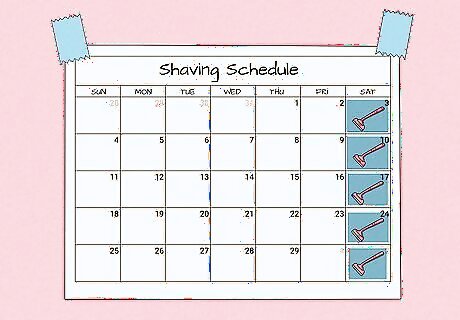
views
Bringing Up the Subject

Find the right time. If you want your mother to give you permission, it’s important to talk to her at a time when she’s receptive to a conversation. That means you probably don’t want to ask her about shaving after she’s had a long, frustrating day at home or work. Try to find a moment when she seems like she’s in a good mood, such as after she’s finished watching her favorite TV show. If you want to increase your chances of your agreeing to let you shave, try asking her right after you’ve done something that shows you’re responsible, such as offering to wash the dishes after a family meal or getting a “A” on an important test. You may want to ask her just before an event or occasion when shaving would make you feel more comfortable, such as a trip to the beach, or maybe wearing a dress to a special occasion. That may help your mother take the request more seriously.

Explain why you want to shave. If you tell your mother that you want to shave just because all of your friends or classmates are doing it, she’s probably going to say no. You need to give her convincing personal reasons why it’s important for you to be allowed to shave. It may even be a good idea to jot down a quick list before hand, so you’re prepared when you talk to your her. Maybe if you say your peers are pressuring you, that would help also. Use a calm tone when you're talking to your mom and she'll be more open to the idea. The key is to convey how uncomfortable your hair makes you to your mother. Point out how dark or plentiful it is, and share if it makes you too uncomfortable to wear shorts, skirts, and swimsuits even in warm weather. If kids at school have teased you about your leg hair, tell your mother about the experience. That may make her more sympathetic to your situation. It usually helps to keep your plea simple. For example, you might say, "I feel really self-conscious when I have to wear shorts for gym class because the hair on my legs is so dark," or "I've stopped going to the pool with my friends because I don't want anyone to see me in a swimsuit with all the hair that I have on my legs." When it comes to actually asking to shave, make it clear how it would help your situation. For example, you might say, "Shaving my legs would really help me feel more comfortable and confident."

Be patient. Your mother may not be prepared to give you an answer right away because she needs time to think about it. She may want to try to remember how old she was when she started shaving, or talk to friends to see when they allowed their daughters to start shaving. Let her have some time to think about your request without pressuring her. If you’re very anxious about getting an answer, you might ask your mother to schedule a specific time to finish the conversation. For example, you might say, “Can you let me know this weekend?” Don’t ask your mother about shaving or hint at the topic at all in the meantime. Respect your mother’s need to consider the topic carefully without you bugging her about it.
Dealing with the Decision

Don’t argue. If your mother agrees to let you shave, it’s obviously easy to accept her decision. However, if she says no, you should still accept it without yelling or whining. Let her explain the reasons why she doesn’t think you should start shaving, and try to understand. By responding in a mature manner, it may help you be able to convince your mother in the future. It’s completely normal to feel frustrated, angry, or upset if your mother won’t allow you to shave. Instead of yelling at her, though, vent to your friends. If she says no, you might say, "I wish you would let me shave, but I understand how you feel. Thank you for considering the idea." She'll appreciate the fact that you're respectful and mature.

Offer a compromise. Even if your mother says no, you may still be able to reach some common ground if you’re willing to compromise. Tell your mother that you’ll only shave below the knees so you’ll feel more comfortable in shorts, or ask if you can just try shaving once for a special occasion, such as a beach party. You might also ask if you can use a hair removal cream instead of shaving. If your mother does agree to a compromise, don’t push the issue and try to ask for more. Be grateful for whatever amount of shaving or hair removal that she’s allowing.

Try again. If your mother says no and isn’t willing to compromise, it can be very frustrating -- but it doesn’t mean that all hope is lost. Now that you’ve broached the subject, your mom is probably going to continue thinking about it, even if she hasn’t allowed you to shave yet. After a little time, ask her again to see if she’s changed her mind. If you responded maturely when she said no before, she may be more receptive to the idea in the future. It can be difficult to wait, but give your mom at least a month or two before you ask about shaving again.
Involving Her in the Process

Ask her to take you shopping. Including your mother in the shaving process may make her more inclined to allow you to shave, so it’s a good idea to ask your mom to take you to the store to buy razors and other shaving items. She’ll probably want to provide advice on what type of razor to use, so it’s easier to have her there with you when you’re picking one out and ensure that you have the right tools and supplies on hand before you begin shaving. Disposable razors are the least expensive, and usually offer a pretty close shave. However, they’re the most likely to nick you so you need to be extremely careful when you use them. Reusable razors with blades that can be replaced are usually sturdier than disposable razors, but can offer just as close a shave, or slightly better. The initial cost of a reusable option is usually higher than disposable, but in the long run, you can actually wind up saving money. They're also better for the environment than disposable razors. Electric razors are more expensive than disposal razors, but they’re less likely to cause cuts or nicks when you’re using them. Keep in mind that they don’t provide the closest shave, though. If you choose to go with disposal razors, you’ll also need a shaving cream or gel to help lubricate the skin when you’re shaving. Be sure to choose an alcohol-free formula because it’ll be less likely to irritate your skin.

Get a demo. Shaving may seem pretty straightforward, but it’s easy to cut yourself and irritate your skin if you’ve never done it before. Your mother may have some good tips and tricks for getting a nice, close shave, so it’s a good idea to ask her to walk you through the process before you do it for the first time. Don’t be embarrassed to ask questions either -- your mother will want to help. In fact, asking her to demonstrate can help reassure her that you know what you're doing, so she's more comfortable with the idea of you shaving. It’s usually best to shave in the shower or bath because the warm water help soften your skin, so it’s easier to glide the razor over your legs without cutting yourself. You’re less likely to get razor burn or other skin irritations if you shave in the direction of your hair growth. While it helps to have your mom to a demo, it’s okay if you want some privacy when it comes time to actually shave. Just be honest with your mother, and tell her you’ll check in with her when you’re done.

Talk about maintenance. Once you’ve shaved for the first time, you’re probably going to want to keep at it so your legs remain smooth and hair-free. Everyone is different, but you should ask your mom about how often she thinks you should shave. She may not want you to shave too often, so if you ask for her input, it may help convince her to allow you to shave. If you have light, thin hair, you may only need to shave once a week. For dark, coarse hair, you may want to shave twice a week. Keep in mind that hair grows faster as you get older. That means that you don’t necessarily need to shave several times a week just because your mother does. Don’t forget to change your razor (or blade) either. If the blade is dull, you’ll be more likely to cut yourself. You can usually get five to ten shaves out of a single razor.


















Comments
0 comment